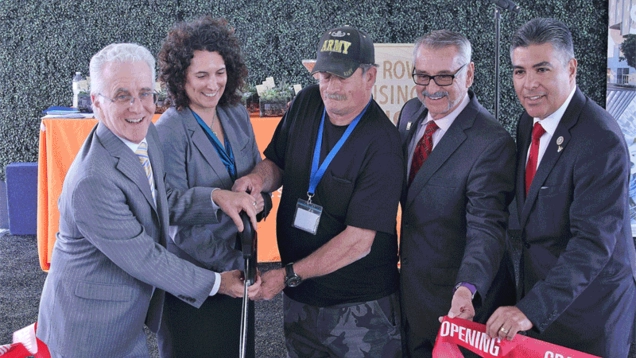
This week at the grand opening of the Crest Apartments, a newly developed permanent supportive housing complex in my district, I met Randy Brader. Randy joined the military at the age of 17 in 1973 and for nearly 20 years, he served our country in the U.S. Army before he was honorably discharged.After a difficult divorce, he was left heartbroken, hopeless and without a support system, soon falling into homelessness. For 10 years, Randy worked odd jobs to get by while living on the streets of Montclair, struggling to survive and uncertain of what would come next. Then, in 2016, Randy suffered a stroke. While recovering at a rehabilitation center, he got connected with services that eventually led him to Crest Apartments where he now lives with the care and support he needs to help him get back on his feet.
The Crest Apartments development is comprised 64 homes dedicated to housing to our most vulnerable neighbors, with comprehensive onsite supportive services to help them build healthier and more stable lives. All of Crest's permanent supportive housing is reserved for homeless people who frequently use Los Angeles County's Department of Health Services' emergency care services, including 23 apartments set aside for homeless veterans. Crest was built in partnership with the Skid Row Housing Trust.
I walked with Randy to take a tour of his new home on the fifth floor of the building, where he excitedly showed me his collection of antique military radios, canteens and other collectible items. He's thankful to have a safe space again that he can call his own. Now, Randy has peace of mind, the mental health services he needs, a new community, and a renewed sense of independence and confidence about his next steps in life.
Working Toward a Solution
The latest results from the Los Angeles Homeless Service Authorities' Homeless Count show that Randy's story is not an anomaly in our city. Last year, LA's homeless population increased by 20 percent. Veterans, women, African Americans and Latinos, and youth are some of the demographic groups suffering increased homelessness. The rising cost of rent, more poverty, and a shortage of affordable and supportive housing are big contributors to the crisis we're facing today.
Although these numbers are alarming, they aren't surprising. In the last few years, we've seen the acuity of this ongoing crisis throughout the city and county, and it's more and more pronounced in the San Fernando Valley everyday. However, there is a silver lining. The number of sheltered families went up by 50 percent across LA County, while placement in housing for previously homeless individuals is up 30 percent over last year. The Crest Apartments and other community projects have made that possible. But it is clear that we need many more.
In the budget just passed by the City Council, we dedicated $176 million to fight homelessness over the next fiscal year, with most of the money set aside for housing and support services, including $89 million from the voter approved Measure HHH. That is the largest amount the city has dedicated to fighting homelessness in its history.
Fighting for the Valley
The San Fernando Valley is one of the areas in the city where homelessness is rising. Driving down neighborhood streets, it's easy to see the many faces who are in need of help. That's why the needs of Valley residents and neighborhoods must be front and center in our search for solutions.
I've been on the forefront of pushing for more services to the unsheltered in my district, including launching a pilot program to pair job training and housing, creating more permanent supportive housing units where possible, and working in partnership with nonprofit and governmental agency providers at my regular Homeless Connect Day events. I will make sure resources are allocated equitably to the Valley so that we have the tools to tackle the problem.
Randy's success story was made possible by the shelter and services provided at the Crest Apartments. That is the kind of success I will strive to replicate as we work to reduce homelessness. His story is a powerful example of what we must do to leave our community in a better place.